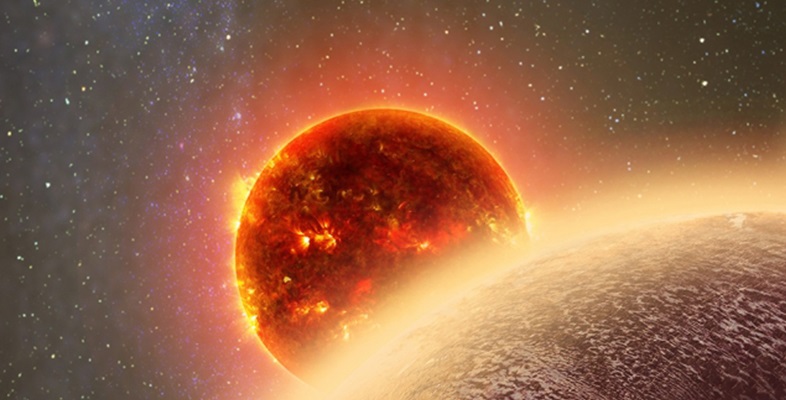Radial velocity
In this activity you will be able to see the radial velocity curve that we’d measure from spectra of the star when an unseen planet is in orbit.
Activity _unit4.4.6 Activity 8 The impact of radial velocity
This application shows you the radial velocity curve for the star, like the example of 51 Pegasi in Figure 12. The green wavy line plots the radial velocity that the orange-brown arrow was measuring in the previous activity. The time on the horizontal axis is measured in Earth years.
Change the orbital inclination to exactly i = 90°. What change do you see in the green radial velocity curve? If you need to start again, refresh the page.
Answer
The radial velocity curve becomes taller. It reaches values of about 40 m/s and –40 m/s. In fact, these values are exactly 36.7 m/s and –36.7 m/s, because the orbital speed of the star is 36.7 m/s.
Now set i = 30°, or close to this. What values do the green radial velocity curve extend to now? What do you notice about these?
Answer
It reaches values of 20 m/s and −20 m/s. This is half the value found when i = 90°.
If you double the star mass, what happens to the orbital speed of the star?
Answer
It goes down, to nearly 26 m/s.
A bigger star will pull the centre of mass towards its own centre so the size of the star’s orbit decreases. Because the star moves around a smaller orbit in one orbital period, its speed decreases. So it would be reasonable to expect that doubling the star’s mass would halve the maximum velocity for that star. But actually it doesn’t.
Move the star’s mass back and forth between about 2 solar masses and 4 solar masses. Watch the screen carefully while you do this.
Apart from the maximum radial velocity of the star, what else changes?
Answer
The orbital period changes.
As recorded below the sliders, it is 4.63 Earth years for Mstar = 2 MSun, and 3.27 Earth years for Mstar = 4 MSun. This is the time for the green radial velocity curve to complete one down and up wave before it repeats itself, which corresponds to one orbit.
In conclusion then, a more massive star moves around a smaller orbit, but it takes less time to complete the circuit. The relationship between star and planet masses, their separation and the time taken to complete an orbit is described by one of the more important laws of astronomy. It’s called Kepler’s Third Law. You don’t need to worry about the equation for it here, but you should know that astronomers use it a lot. It is the fundamental method used to determine the mass of everything in astronomy, from our familiar Sun and Moon to the black hole at the centre of our Galaxy, and it can even be modified to be used on entire galaxies. If you study more astronomy you will definitely come across it again.
Set the mass of the star to exactly 1 MSun.
Set the mass of the planet to exactly 1 MJ.
Set the planet distance from the star to be aplanet = 5.2 AU.
What is the orbital period of the star–planet system that has been chosen?
Answer
11.9 Earth years.
Can you name a planet–star pair that has properties very like the one that has been chosen?
Answer
The application has been set up to simulate the orbit of Jupiter and the Sun, ignoring the effects of all the other Solar System planets.
Using the sliders, adjust the application to find out what the orbital period of a planet like Jupiter would be if it were at a distance of 1 AU from the centre of mass.
What value do you get for the orbital period? Comment on your answer.
Answer
The orbital period is 1.00 Earth years. If Jupiter were put in Earth’s place in the Solar System, then it would follow the Earth’s orbit, taking one Earth year to complete it, just like Earth does.
Because the Sun is more than 1000 times more massive than even Jupiter, the most massive planet in the Solar System, it is the mass of the Sun that dominates. It is the value of the Sun’s mass that determines how long it takes for any planet in the Solar System to complete its orbit.
Using the sliders in the application, find out what the orbital period would be for a Jupiter-like planet orbiting at 1 AU from a star with a mass of 5 MSun.
Answer
0.447 Earth years.
Reading from the graph, what is the maximum radial velocity for this system? (Remember that you may need to adjust the orbital inclination to see the maximum value.)
Answer
Just over 12 m/s.
This is the maximum value, obtained with orbital inclination i = 90° exactly.
